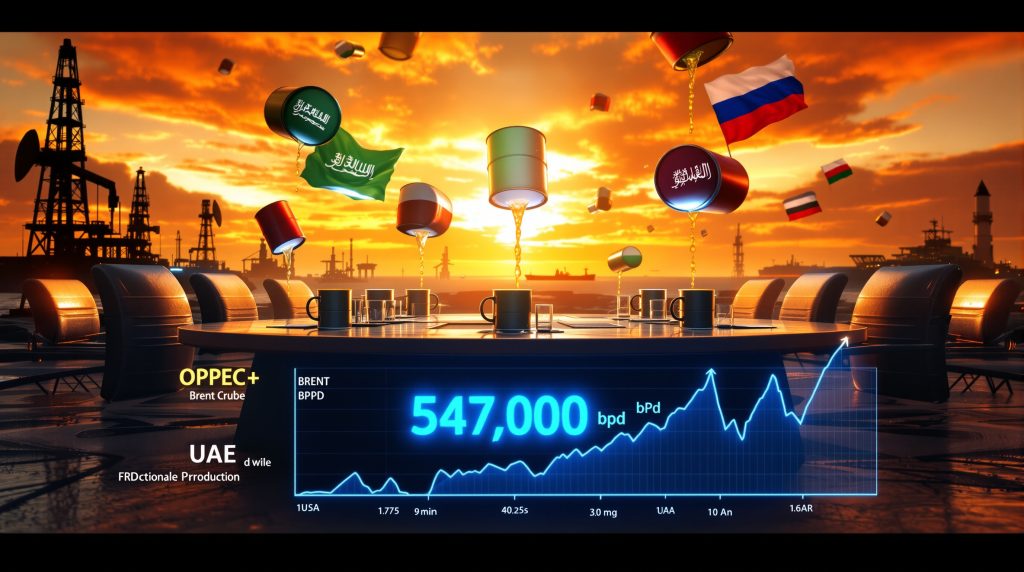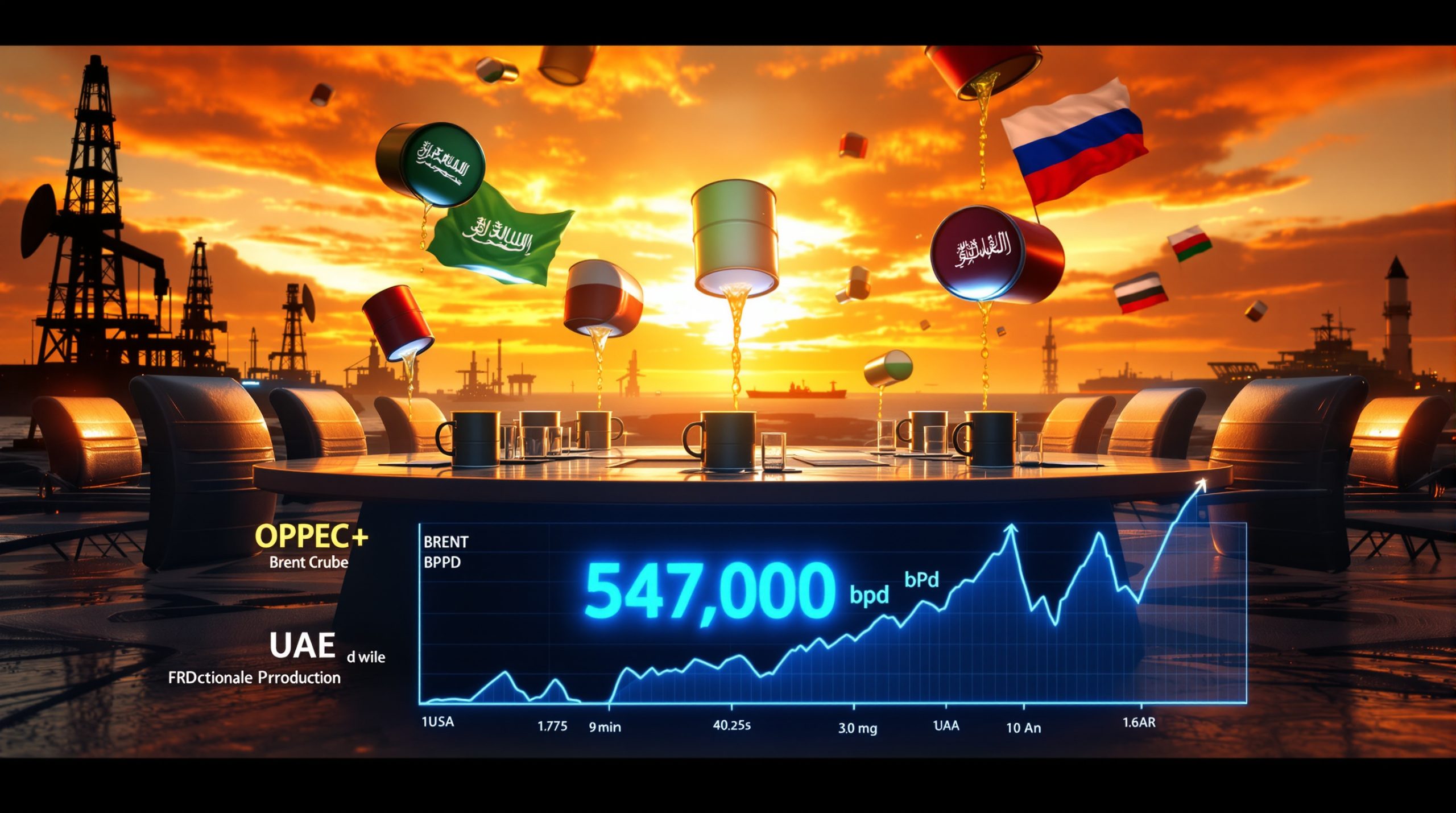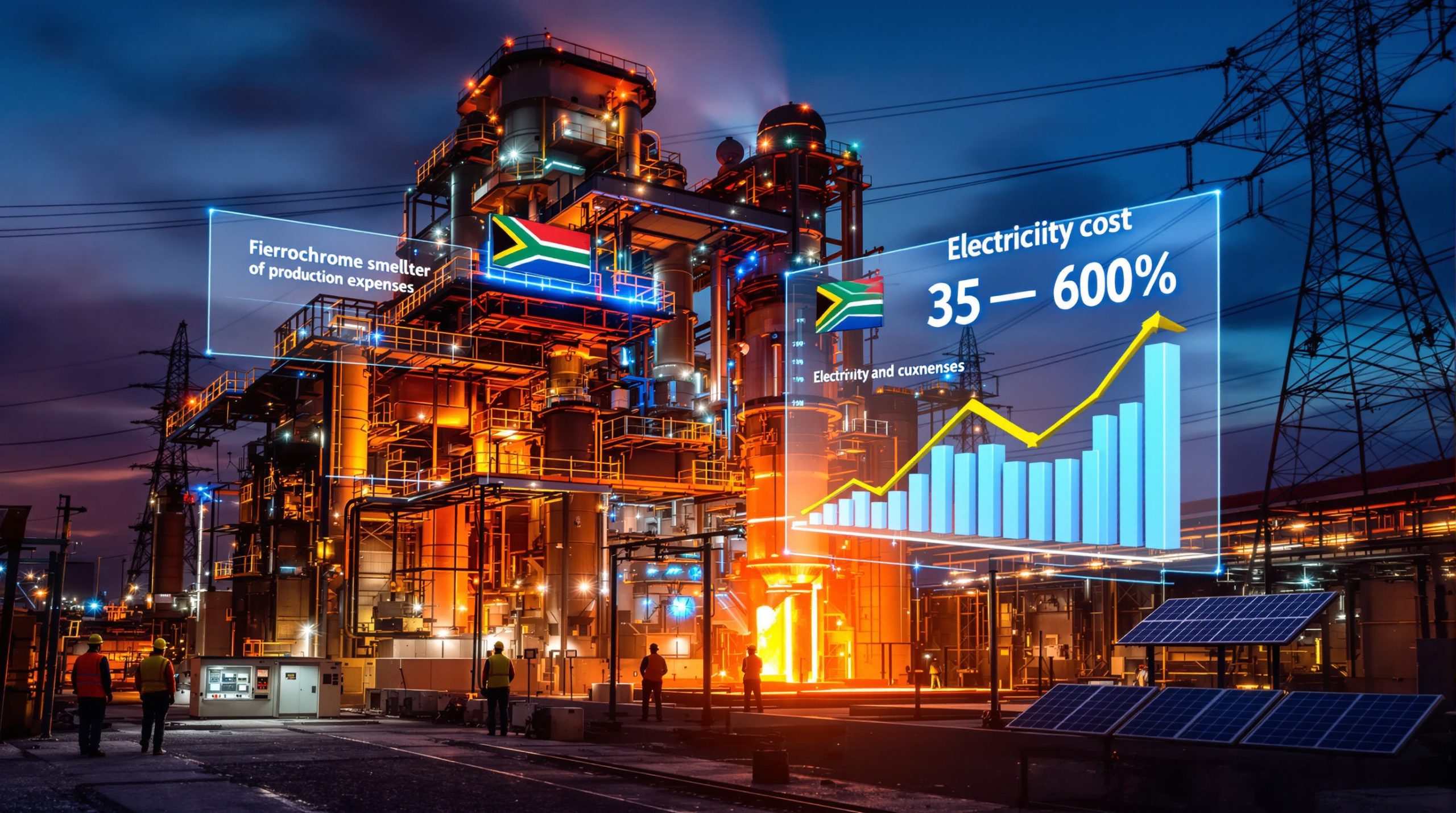What Is Driving OPEC+'s Decision to Increase Oil Production?
OPEC+ has agreed to boost oil production by approximately 547,000 barrels per day starting September 2025. This strategic move represents the latest phase in the group's careful unwinding of previous production cuts implemented to stabilize prices during periods of market volatility. The decision reflects a calculated response to shifting market dynamics, geopolitical pressures, and internal member priorities.
Several key factors have influenced this decision:
- Gradual recovery in global oil demand despite economic uncertainties
- Strategic positioning ahead of seasonal demand fluctuations
- Balancing market share concerns among member nations
- Responding to diplomatic pressure from major consuming nations
- Managing price stability while increasing revenue opportunities
The production increase continues OPEC+'s methodical approach to market management, with the group having already restored about 1.64 million barrels per day from earlier voluntary cuts of 2.2 million bpd implemented in late 2023 and early 2024.
How Will the Production Increase Affect Global Oil Markets?
Price Implications and Market Response
The announced production hike has triggered mixed market reactions. Initial price movements showed moderate declines as traders processed the implications of additional supply entering the market. Key impacts include:
| Market Response Factor | Short-Term Impact | Medium-Term Projection |
|---|---|---|
| Brent Crude Price | 2-3% decline following announcement | Projected to average $59-62/barrel in Q4 2025 |
| WTI Crude Price | 1.8-2.5% decline initially | Expected to trade at $4-5 discount to Brent |
| Market Volatility | Increased in first 48 hours | Likely to stabilize as supply integration occurs |
| Inventory Levels | Gradual build expected | EIA projects global inventory growth of 0.8-1.2 million bpd |
Despite the production increase, several market analysts note that the actual impact may be less dramatic than headline figures suggest. Many OPEC+ members continue to produce below their assigned quotas, meaning the theoretical increase may not fully materialize in actual barrels reaching the market.
Supply-Demand Balance Forecast
The production increase occurs against a backdrop of complex supply-demand dynamics:
- Global oil demand growth has slowed to approximately 1.1 million bpd in 2025, down from 1.8 million bpd in 2024
- Non-OPEC+ supply continues to grow, particularly from the Americas and Guyana
- Strategic petroleum reserve replenishment programs in major economies have slowed
- Seasonal demand patterns suggest stronger consumption in Q4 2025 and Q1 2026
The U.S. Energy Information Administration projects that the combination of OPEC+ production increases and slowing demand growth will lead to inventory builds through early 2026, potentially pushing Brent prices toward $50 per barrel by Q1 2026 if all announced production increases materialize.
Who Are the Key Players in the OPEC+ Production Decision?
Saudi Arabia's Central Role
Saudi Arabia remains the pivotal decision-maker within OPEC+, wielding significant influence through its substantial spare production capacity and role as the group's de facto leader. The kingdom's approach reflects several strategic considerations:
- Balancing fiscal needs against price stability goals
- Maintaining market share in key export destinations, particularly Asia
- Managing relationships with both OPEC+ partners and major consuming nations
- Positioning for longer-term energy transition challenges
Saudi Arabia will contribute approximately 212,000 bpd to the overall production increase, representing about 39% of the total hike. This proportional increase aligns with the kingdom's production capacity and historical role in market management.
Russia's Influence and Positioning
As the leading non-OPEC member of the alliance, Russia's participation remains crucial despite ongoing sanctions and export challenges. Russia has agreed to increase production by approximately 127,000 bpd as part of the coordinated action. This decision comes amid:
- Continued export restrictions to certain markets
- Logistical challenges in redirecting crude flows
- Pressure to maintain oil revenues for fiscal stability
- Geopolitical considerations related to the Ukraine conflict
Russian officials have indicated that their production capacity allows for the planned increase without compromising field management or future output potential.
UAE's Expanded Production Allowance
A notable development in the latest OPEC+ agreement is the special accommodation for the United Arab Emirates, which received permission to increase production by an additional 300,000 bpd beyond its proportional share of the coordinated hike. This unique arrangement reflects:
- The UAE's substantial investments in production capacity expansion
- Internal OPEC+ negotiations to accommodate member priorities
- Recognition of Abu Dhabi's long-term production growth plans
- Strategic balancing to maintain coalition cohesion
The UAE's expanded production allowance represents a significant diplomatic achievement for Abu Dhabi within the OPEC+ framework and acknowledges its growing importance in global oil markets.
What Are the Broader Economic Implications of the Production Increase?
Impact on Energy Inflation and Consumer Prices
The OPEC+ oil production hike may help moderate energy inflation pressures that have affected major economies throughout 2024 and early 2025. Key economic implications include:
- Potential moderation in transportation fuel costs
- Reduced input costs for manufacturing and petrochemical industries
- Easing of inflationary pressures in energy-dependent sectors
- Improved consumer purchasing power in oil-importing economies
Economic analysts suggest that each $10 decrease in crude oil prices typically translates to approximately 20-25 cents per gallon reduction in gasoline prices, though local taxes and refining dynamics affect the final consumer impact.
Fiscal Implications for Producer Economies
For oil-producing nations, the production increase represents a calculated trade-off between price and volume. The fiscal implications vary significantly across OPEC+ members:
- Saudi Arabia requires approximately $65-70 per barrel to balance its budget
- Russia's fiscal breakeven has adjusted to around $60-62 per barrel
- UAE and Kuwait maintain lower fiscal breakeven points of $50-55 per barrel
- Higher-cost producers like Nigeria and Angola face greater fiscal pressures
The collective decision suggests that major producers believe the volume increase will offset potential price declines, maintaining or improving overall revenue. However, this calculation depends heavily on actual market response and demand growth through late 2025 and early 2026.
How Does the Production Hike Fit Into OPEC+'s Longer-Term Strategy?
Phased Unwinding of Production Cuts
The September 2025 production increase represents part of a carefully orchestrated unwinding of previous cuts. OPEC+ implemented voluntary production cuts totaling 2.2 million bpd in late 2023 and early 2024 to support prices during demand uncertainty. The current increase continues a phased approach:
- April 2025: Initial restoration of 573,000 bpd
- June 2025: Second phase adding approximately 800,000 bpd
- September 2025: Current phase adding 547,000-548,000 bpd
- Remaining: Approximately 280,000 bpd still to be restored
This methodical approach allows OPEC+ to monitor market reactions between implementation phases and adjust timing if necessary. The group maintains the flexibility to pause or reverse the unwinding process if market conditions deteriorate unexpectedly.
Balancing Market Share and Price Stability
OPEC+'s strategy reflects an ongoing tension between maintaining price stability and preserving market share. The production increase signals several strategic considerations:
- Concern about losing market share to non-OPEC producers
- Recognition of growing competition from alternative energy sources
- Desire to maintain relevance in global energy markets
- Balancing short-term revenue needs against long-term market position
By increasing production moderately while maintaining substantial cuts (approximately 3.66 million bpd remain in effect through various OPEC+ agreements), the group aims to achieve a delicate balance between these competing priorities.
What Are the Geopolitical Dimensions of the OPEC+ Decision?
Diplomatic Pressures and International Relations
The OPEC+ production increase occurs against a backdrop of complex international relations and diplomatic pressures:
- Major consuming nations have advocated for increased production to moderate prices
- Geopolitical tensions in multiple regions affect energy security perceptions
- Shifting alliances within and outside OPEC+ influence decision-making
- Energy transition policies in major economies create long-term market uncertainty
The production increase may partially address concerns from major consumers while preserving OPEC+'s autonomy in market management. The timing also coincides with diplomatic initiatives related to various regional conflicts, suggesting potential linkages between energy policy and broader geopolitical considerations.
Energy Security Implications
For energy-importing nations, the OPEC+ production increase offers modest improvements in supply security:
- Increased global spare capacity as production constraints ease
- Potential moderation in price volatility
- Improved inventory positions heading into winter 2025-2026
- Reduced pressure on strategic petroleum reserves
However, the production increase also underscores the continuing influence of OPEC+ in global energy markets, highlighting the ongoing challenges of energy security in a transitioning but still oil-dependent global economy.
How Might Market Conditions Evolve Following the Production Increase?
Near-Term Market Outlook
In the months immediately following the September 2025 production increase, several key market developments bear watching:
- Actual implementation rates among OPEC+ members
- Inventory accumulation patterns across major consuming regions
- Price differentials between key crude benchmarks
- Refining margin trends and product demand balances
- Seasonal demand patterns heading into winter 2025-2026
Market analysts project a period of price discovery as traders assess the real-world impact of the announced increases against evolving demand patterns. The initial price reaction may not fully reflect longer-term market adjustments as supply gradually increases.
Potential Scenarios and Risk Factors
Several scenarios could develop following the production increase, each with different implications for market participants:
Baseline Scenario: Production increases are fully implemented, demand grows modestly, and prices stabilize in the $60-65 range for Brent crude by year-end 2025.
Bearish Scenario: Demand growth disappoints, non-OPEC supply exceeds expectations, and prices decline toward $50-55 by early 2026, potentially triggering OPEC+ to reconsider further unwinding.
Bullish Scenario: Supply disruptions, stronger-than-expected demand, or new geopolitical tensions offset the production increase, maintaining prices above $70 despite the additional barrels.
Key risk factors that could shift the market from the baseline scenario include:
- Unexpected economic developments in major consuming regions
- Weather-related demand disruptions
- Supply outages in key producing regions
- Policy changes affecting energy markets in major economies
- Further OPEC+ policy adjustments in response to market conditions
Conclusion: Balancing Act in an Uncertain Market
The OPEC+ decision to increase oil production by 547,000 barrels per day represents a carefully calibrated response to evolving market conditions. The move continues the group's methodical unwinding of previous production cuts while maintaining substantial supply management through remaining restrictions.
For market participants, the production increase introduces new variables into an already complex energy landscape. While the headline figure suggests significant additional supply, the actual market impact will depend on implementation rates, demand trends, and broader economic conditions.
The decision underscores OPEC+'s continuing influence in global oil markets while highlighting the delicate balance the group seeks to maintain between price stability, market share, and member priorities. As the additional barrels enter the market through late 2025, both producers and consumers will be watching closely to assess whether this calibrated approach achieves its intended outcomes.
Furthermore, the potential for oil price rally remains a concern for many market analysts who see geopolitical factors potentially offsetting the production increases. The complex interplay between supply increases and shifting demand patterns could lead to periods of oil price stagnation as markets adjust to the new supply environment. Meanwhile, the ongoing US oil production decline adds another layer of complexity to global supply considerations, potentially offsetting some of OPEC+'s increased output.
Concerns about global tariff impact on trade flows could further complicate oil market dynamics, potentially creating regional price disparities and affecting shipping patterns. Some economists warn that an escalating oil price trade war could undermine OPEC+'s careful calculations and introduce additional volatility to markets already adjusting to the production increases.
Further Exploration:
Readers interested in learning more about OPEC+ oil production decisions and their market impacts can also explore related educational content at OPEC's latest production plans, which offers ongoing coverage of global energy markets and production trends. For additional insights into how OPEC decisions are affecting energy markets, the New York Times analysis provides valuable perspective on the broader economic implications.
Want to Stay Ahead of the Next Major Mineral Discovery?
Discover significant ASX mineral discoveries before the market with Discovery Alert's proprietary Discovery IQ model, delivering real-time notifications that transform complex data into actionable investment opportunities. Explore our dedicated discoveries page to understand how major mineral discoveries have historically generated substantial returns for early investors.




